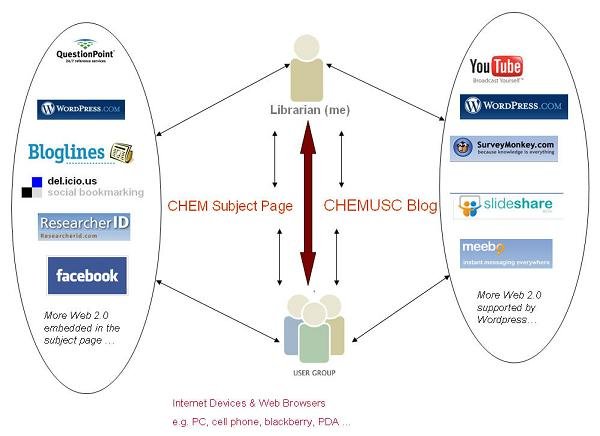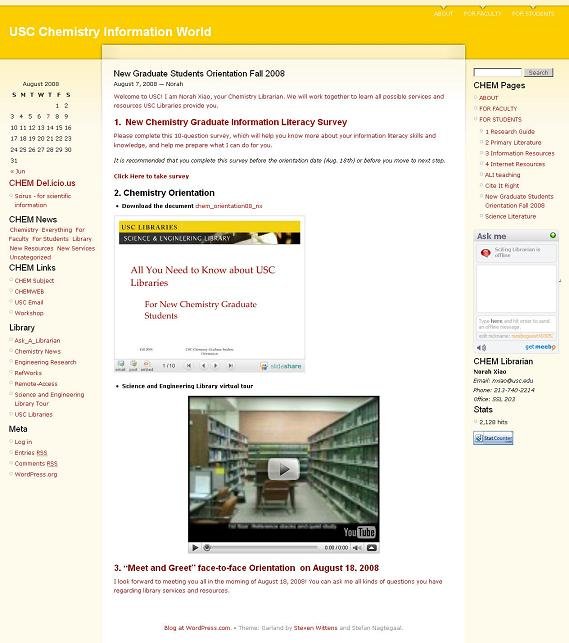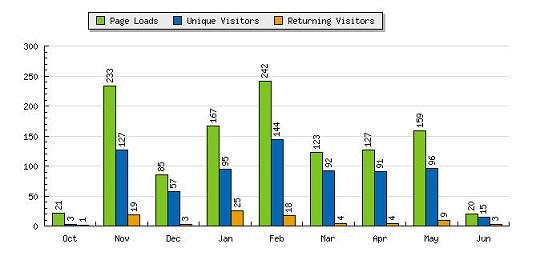| URLs in this document have been updated. Links enclosed in {curly brackets} have been changed. If a replacement link was located, the new URL was added and the link is active; if a new site could not be identified, the broken link was removed. |
Web 2.0 as Catalyst: Virtually Reaching Out to Users and Connecting Them to Library Resources and Services
Librarian
Science and Engineering Library
University of Southern California
Los Angeles, California
nxiao@usc.edu
Abstract
This article is based on services to library users in the area of chemistry at the Science and Engineering (S&E) Library of the University of Southern California (USC), to which I applied various new technologies as outreach approaches. Various Web 2.0 technologies such as a blog, tags, YouTube, RSS feeds, Instant Messaging, online presentation and e-surveys have been selected to overcome challenges in the current library framework and to enhance the effectiveness of the approaches. These Web 2.0 technologies function as catalysts which help lower human barriers between my users and me, enable me to reach my users virtually, and attract users to resources from the library as well as various services I provided.
Background
I started as a librarian at the USC Science and Engineering Library in May 2007 and have been serving science and engineering information users, especially graduates, researchers, and faculty since then. One of my subject assignments is chemistry and I serve the Chemistry Department, one of the biggest departments in the College of Letters, Art and Science at USC with 32 full-time tenured faculty members, 130 full-time Ph.D. candidates, 55 post-doctoral research associates, many senior researchers, and visiting scholars. With an education background in chemistry and library science, as well as years of working experience in academic libraries, I was very excited about the assignment.However, the assignment was challenging due to some limitations of the chemistry web page and unique issues as related to the information seeking behavior of chemical information users (users). Historically, few outreach activities existed to establish the connection between users and the chemistry librarian at USC Libraries; for instance, students did not receive any subject-specialized library training and faculty members did not know specifically who to contact for their teaching and research information needs.
The information seeking behavior of users also presents some unique challenges. Most users rely heavily on primary literature, especially journal articles, in their research and study and they focus their information research on several key databases such as SciFinder Scholar, Web of Knowledge, MEDLINE, etc. With more e-resources (e.g., full-text journals and electronic databases) available, more and more users tend to visit the library virtually or obtain needed information from the Internet. Although statistics show e-resources are being used, they do not indicate whether users are fully aware of the variety of information resources or library services available to them. In some cases, users may depend solely on what they have known, and isolate themselves from the library; our students would not fully develop critical thinking skills or information research skills.
In addition, as a typical Library 1.0 platform, there are limitations intrinsic to the USC chemistry subject page. Similar to other academic libraries' subject pages, this web page simply presents basic information of collections and services statically. Issues regarding this page are as follows:
- Except for minor modifications, the subject page template is the same as the library page template, both of which are designed around services offered in physical libraries and do not necessarily meet the needs of users who seldom set foot in the library.
- Content management systems (CMS) have been favored by library administrators as CMS provide a professional looking wrapper around content. CMS are used to make data entry easy; however, they also limit the format and content choices. There is a cookie-cutter sameness across pages regardless of the needs of a given discipline or clientele. For that reason, subject pages are not significantly different from print subject guides in form and content. As they do not take advantage of RSS and other technologies, the pages lack the functionality to allow interaction between users and librarians.
- USC's e-resource list is driven by content selected for the widest possible user base and has included many multi-disciplinary resources that are rarely used by accomplished researchers for the subject areas.
- Usability testing may only be done at the highest levels of the library site. As the usability of subject pages is not tested by end users, no baseline data are available to librarians regarding the effectiveness of the subject pages.
Leveraging Web 2.0 to Library Service
Many Web 2.0 technologies have been adopted in library services to increase the social interaction between users and librarians, to build up virtual libraries, and to manage the content of library web pages innovatively. MIT library is an excellent example (Duke et al. 2006). Other librarians have also experimented with Web 2.0 applications in their services (Baldwin 2007; Barsky & Purdon 2006; Golder & Huberman 2006; Okamoto 2006; Sadeh 2007; Secker & Price 2007). This article will not discuss extensively every Web 2.0 application used in the library services and their pros and cons, but instead focuses on how the ideas of Web 2.0 virtual services have been implemented, why various technologies have been embedded in the web sites created, as well as what the advantages of the model are as compared to traditional approaches.As illustrated in the Figure 1, a blog with embedded Web 2.0 technologies has been created alongside the enhanced subject page with additional Web 2.0 functions. On one hand, the usefulness of the Chemistry subject page has been greatly improved through the use of Blogline, Delicious tags, ResearcherID, etc. On the other hand, the creation of the blog has significantly expanded the capability of the librarian and the depth of the library services through the extra functions that were not available on the subject page before. The key elements of this collaborative model and its unique benefits to the outreaching efforts will be discussed in the following sections.

Figure 1: Demonstration of the Collaborative Model with Two Web sites (Traditional Subject Page + Web 2.0 Blog) and Their Embedded Web 2.0 Applications
The Collaborative Model
To address the limitations of the static page, the {CHEMUSC blog} has been implemented in addition to the {chemistry subject page}. The blog site should ideally be hosted on a free web platform that does not need extra hardware support but offers as many editing functions and embedded technologies as possible. Based on the above criteria, the WordPress blogging platform was chosen. To help users memorize the newly created site, the site was named as CHEMUSC. In addition, CHEMUSC was designed with great similarities and {the same color scheme} as the USC Libraries' home page.To enhance the effectiveness of my virtual services, many Web 2.0 technologies that are quite popular and well used by people outside the library world are included in both web sites. Seamlessly incorporated in the model, these technologies have demonstrated great versatility in expanding the reach of library services.
- {News blog} and RSS news reader keep users up-to-date with information from the library and chemistry, and abreast of recent research developments;
- Instant Messaging (IM) reference attends to users' virtual reference questions without time and space limitations (via QuestionPoint and Meebo);
- A {research guide} based on the CHEMUSC subpage covers chemistry information resources according to the life cycle of scientific information and arranges resources according to users' information needs;
- ResearcherID or similar Web 2.0 features provided by research databases allow users to adapt to their own information needs.
- Visually attractive {De.licio.us tags} create a unique chemistry Internet resources collection that can be accessed easily by users and maintained effortlessly by the librarian compared to a traditional Internet links collection.
Via these technologies, I have vastly increased the possibilities for users to be unobtrusively exposed to resources and services virtually.
Examples of Utilizing the Collaborative Web Sites
One of best uses of this model has been my approach to the Fall 2008 new graduate students orientation in which I utilized Web 2.0 technologies to reach out to my users proactively well before the in-person orientation. The virtual orientation (Figure 2) was prepared on the CHEMUSC blog, which contains a 10-question e-survey from SurveyMonkey to test these students' information literacy; an {on-line presentation} via SildeShare about the USC Libraries services and resources; and an online tour of the S&E library via YouTube.

Figure 2: Fall 2008 New Chemistry Graduate Students Orientation
Through this practice, my users have familiarized themselves with the library's physical setting (via YouTube), understood their information literacy level (via the e-survey) and were prepared for the later in-person orientation (via Slideshare). Using the e-survey also enabled me to establish the services base line for these students and assisted me in preparing an in-person orientation and further library training workshops.
As a result, the virtual orientation greatly enhanced the effectiveness of the whole orientation event. All students responded in a follow-up survey that they know who the Chemistry librarian is, expressed great interest in library resources, and desired to contact the librarian for assistance on upcoming questions.
Usage Analysis of the Two Web Sites in Collaborative Model and Outreach Success
There has been significant increase in use since the launch of the Web 2.0 services in the collaborative web sites in August 2007. The chemistry subject page has become much more popular according to USC Libraries page analysis (Figure 3). When comparing the statistics for the same time period (January-June) before and after redesign, the analysis demonstrated that CHEM subject page has attracted significantly more users than before (Figure 4).

Figure 3: Usage Statistics of the Chemistry Subject Page from August 2007 to May 2008 by Google Analyst

Figure 4: Comparison of Usage Statistics of the Chemistry Subject Page from January to May in the Year of 2007 and 2008 by Google Analyst
Further analysis on the usage statistics based on StatCounter embedded on the CHEMUSC blog also revealed that users had consistently visited the CHEMUSC site for their topics of interest(Figure 5).

Figure 5: Usage Statistics of the CHEMUSC Blog from October 2007 to June 2008 by StatCounter
With this collaborative model and my great effort in seizing every outreach opportunity, many users have in turn reached me in the real world as a result of their virtual space experience.
- Faculty members, after knowing my background as a chemist and after outreach by me, recognized me as their librarian. Gradually they invited me to their research groups for customized resources workshops, as well as their sub-research divisions' faculty meetings for library services updates; they also constantly recommended book titles, journals, and databases for consideration, and even willingly met with me for a discussion of approval plan policies. Moreover, faculty acknowledge the work I have done for them and their students, and have suggested the department chair and the Chemistry Graduate Students Advisor Committee authorize my access to the graduate students' e-mail list so that I can communicate with students more easily and directly. This was the first time that a librarian was given access to the chemistry graduate e-mail list.
- At the same time , many graduate students have become friends and feel comfortable in turning to me for questions while conducting their research. Since Fall 2007 my personal reference records have grown every month from zero to about 50-70 per month, most of which are advanced reference questions and in-person questions.
Conclusions and Future Thoughts
The results, in combination with positive feedback from faculty and students, have greatly demonstrated the success of the collaborative model. The key to this success is that it is driven by users' needs and has made maximum use of the core concepts of Web 2.0 in library services, including user-centered services, socially rich human interaction, active participation, and communal innovation (Maness 2006; Miller 2005; Stephens & Collins 2007). In this model, users and librarians unite through virtual channels where they are interacting, communicating, sharing, and contributing via Web 2.0 applications. Librarians are not only content creators or contributors, but also facilitators who disseminate information. At the same time, users have the ability to find out about the library virtually, have a place where they can interact with the librarian, learn what they need when there is a need, and contribute and participate accordingly.The use of Web 2.0 in this collaborative model correlates to the role of the catalyst in a chemistry reaction. In the world of chemistry, a catalyst lowers the activation energy and finds an alternative pathway for the reactants with an increased reaction rate. As a result, the reaction takes place without catalysts being consumed. This is what Web 2.0 does for me in my virtual outreach. It lowers the barriers between my users and me, provides innovative approaches, and accelerates the reaction of "connecting the users to library services and resources."
With its great versatility, Web 2.0 has become an integral part of my outreach efforts. However, similar to catalysts in a reaction, Web 2.0 applications are not reactants. The best library services are geared toward users' needs and based on human interaction that needs emotional and intellectual human attention. In the end the best catalysts in public services are librarians with their knowledge, skills, and dedication to users, without which Web 2.0 is only technology. The true meaning of Web 2.0 (or Library 2.0) encompasses more social or human interaction via web technologies supported by a fast and convenient computing platform.
Notes
- This article is based on the poster presented in the ALA poster session as well as ALA-STS poster session in 2008.
- As of Fall 2008, USC Libraries began subscribing to LibGuides, a web 2.0 content management and information sharing system designed specifically for libraries that shares a model similar to what is presented in this article.
- The author wishes to acknowledge Victor Li and Deborah Holmes-Wong for their help and support in writing.
- The e-Survey questionnaire for new graduate students will be shared upon request.
References
Baldwin, V. 2007. Using new technologies for library instruction in science and engineering: Web 2.0 applications. Science & Technology Libraries 27(3), 91-99.Barsky, E., & Purdon, M. 2006. Introducing web 2.0: social networking and social bookmarking for health librarians. Journal of the Canadian Health Libraries Association 27(3), 65-67.
Duke D., Hartman S., Locknar A. 2006. Reaching the engineering and science communities: new technologies and approaches at MIT. Issues in Science and Technology Librarianship. [Online]. Available: http://www.istl.org/06-winter/article1.html [Accessed August 27, 2008].
Godwin, P. 2006. The challenge of the Google generation to information literacy. ALISS Quarterly 2(1), 13-19.
Golder, S.A. and Huberman, B.A. 2006. Usage patterns of collaborative tagging systems. Journal of Information Science 32(2), 198-208.
Maness J.. 2006. Library 2.0 theory: web 2.0 and its implications for libraries. Webology 3(2). [Online]. Available: http://www.webology.ir/2006/v3n2/a25.html [Accessed August 27, 2008].
Miller P. 2005. Web 2.0: building the new library. Ariadne 45 [Online]. Available: http://www.ariadne.ac.uk/issue45/miller/ [Accessed August 27, 2008].
Okamoto, M. 2006. Libraries in the age of "Web2.0" - blog, RSS, SNS and CGM. Journal of Information Science and Technology Association (Joho no Kagaku to Gijutsu) 56(11), 502-508.
Sadeh, T. 2007. Time for a change: new approaches for a new generation of library users. New Library World 108(7-8), 307-316.
Secker, J., & Price, G. 2007. Libraries, social software and distance learners: blog it, tag it, share it! New Review of Information Networking 13(1), 39-52.
Stephens, M., & Collins, M. 2007. Web 2.0, library 2.0, and the hyperlinked library. Serials Review 33(4), 253-256.
| Previous | Contents | Next |
